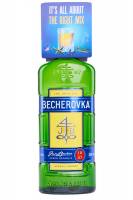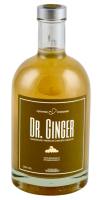The history of herbal liqueur
The history of herbal liqueur began in the 13th century. Back then, Arnaldus de Villa Nova, the leader of the medicinal faculty in Montpellier, brought the art of distillation back to Europe. Soon he began distilling typical healing plants and herbs to extract their active ingredients.
While Arnaldus de Villa Nova intended to use the herbs exclusively for medicinal purposes, people soon started drinking liqueurs for enjoyment. To compensate for the bitter taste of the distillate, producers started adding high amounts of honey or sugar.
Unlike today, sugar was an absolute luxury good in medieval times. The high price of sugar made it so that only the wealthiest classes were able to afford liqueurs. It took until the beginning of colonialism for this situation to change, which is when the consumption of liqueur became much more prevalent in big parts of the population.
What is liqueur?
Liqueur is available with a base of many different spirits (vodka, gin, whisky and more) and can be made from many different ingredients – however, all liqueurs have one commonality: They contain at least 100 grams of sugar per litre. If a liqueur contains more than 250g per litre, the term “crème” is sometimes used.
How is herbal liqueur produced?
In general, one has to distinguish between clear and non-clear herbal liqueur. When it comes to clear herbal liqueur, the botanicals are usually macerated in alcohol for days or weeks to extract the aromas. Clear herbal liqueurs go through an additional distillation which leads to the refinement of the flavour. These liqueurs are usually lighter and more tender than non-clear herbal liqueurs. Before the bottling, sugar is added to the spirit.
What popular herbal liqueurs are there?
The most popular international herbal liqueurs include Jägermeister, Angostura Bitter, Chartreuse Verte, Suze, Badel Pelinkovac, Meyer’s Bitter, Ramazzotti, Unicum, Underberg and Becherovka. Additionally, countless of delicious regional herbal liqueurs are produced in Germany and Switzerland.
How to drink herbal liqueur
Herbal liqueurs are considered digestifs. A digestif is an alcoholic beverage which is consumed after a meal. Conversely, an aperitif is consumed before a meal. Herbal liqueurs are especially popular as digestifs due to their bitter substances. These stimulate the stomach lining to produce more acid and therefore aid with the digestion of the meal. However, this effect has nothing to do with the alcohol or sugar that the liqueur contains.
Of course, herbal liqueurs can also be consumed on their own. In the last 15 years, bitters have become downright party drinks. Additionally, there are long drinks and cocktails like the Jägermeister Orange, Old Cuban or the Flying Hirsch that are great for every occasion.
At Gustero
Whether you’re looking for a gift or you want to give yourself a gift, in our shop you can discover a multitude of exciting international herbal liqueurs that you can enjoy as digestifs, in mixed drinks or on their own. Take a look at our large assortment now and find your new favourite liqueur!




































